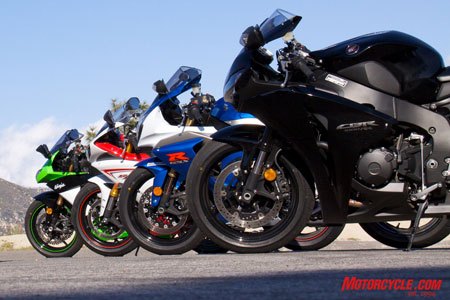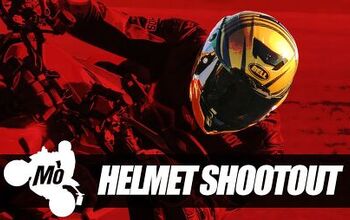2009 Literbike Shootout - Motorcycle.com
Get the Flash Player to see this player.
It’s been nearly 12 years since I began working as a full-time motojournalist, and I get wistful for those simpler days. Back then, the literbikes (CBR900RR, ZX-9R, GSX-R1100 and YZF1000) were separated by nearly 100 pounds of weight and huge power disparities, and ergonomics ranged from racetrack refugee to something we now call sport-tour-y. Even a neophyte motojourno could pick a clear winner.
But today, we’re stuck in a world of finely honed and fully featured literbikes whose level of diversity is amazingly insignificant. They all haul ass around a racetrack, chassis geometry distinctions are measured in fractions, and peak horsepower differs only by about 5%. Unless you’re a nationally ranked Superbike racer, each of these bikes is way better than you are, and saying one is significantly better than another is mere hair-splitting.
If a person could ride a bike blindfolded (maybe next shootout…), they’d be hard-pressed to discern which literbike they were on. Jumping from one model to another at the racetrack, it was astounding to be fully comfortable running quick laps immediately on another brand’s bike, as they all have remarkably high performance envelopes yet are amazingly user-friendly for what are essentially road-bound missiles.
Stellar radial-mount brakes with monoblock calipers? Check. Race-derived slipper clutches? Check. About 150 tire-shredding horsepower? Check. Same for high-tech fuel-injection systems, stiff inverted forks, comprehensive electronic instruments and calming steering dampers.
Last year, Honda delivered a finely engineered sport tool in its then-new CBR1000RR, and we liked it so much that we awarded it the victory in our literbike shootout. Though unchanged for ’09, the RR retains its punchy, midrange-heavy powerplant inside a package that weighs less than any of its natural rivals.
Threatening the Honda’s class king status are two new-from-the-ground-up competitors. Arriving with a splash is Yamaha’s R1, endowed with a revolutionary cross-plane crankshaft like Valentino Rossi’s MotoGP machine. We loved its tractable power when we rode it at Australia’s Eastern Creek circuit late last year, and we were anxious to see how this fresh design would stack up against the usual suspects.
Also fresh to the literbike equation is Suzuki’s all-new GSX-R1000. Pete recently came back from its racetrack intro gushing praise over the latest, greatest Gixxer. Composed handling and major-league power is assured, aided by the addition of Showa’s new Big Piston Fork first seen on the new ZX-6R.
And lurking in the shadows is the unchanged Kawasaki ZX-10R. But let’s not underestimate last year’s shootout runner-up, as its burly motor still challenges for class honors, and its 2008 redesign handles much livelier than its previous iteration. And the big Ninja has an ace up its sleeve by the fact that it retails for $1200 less than the most expensive bike in the class.
And speaking of the class, we happened to have a Ducati 1198S hanging around while our shootout was going on, so we brought it along on our street ride and our day spent lapping Willow Springs International Raceway with our friends at Track Daz. However, at least 50% of the Japanese OEMs objected to comparing their sub-$13,000 machines with the lusty $21,795 Ducati, especially since their bikes don’t yet have a traction-control system to compete with Ducati’s. And then there’s the fact that the sexy Duc isn’t technically a literbike, it’s a 1.2-liter-bike. So, in the interest of playing nice, we’re including the 1198S mainly as a sidebar story.
So, with all this new blood in the mix, one might expect a drastic reshuffling of last year’s finishing order. Well, without giving our conclusion away early, let’s just say that we were amazed at how well matched this crop of literbikes are. In fact, even after we finished all our testing, no one could say for certain which bike was best. Our winner would be determined purely by the results on scorecards. Read on!
By Pete Brissette
Mixing the Ducati 1198S in with a group of inline-Fours that share unprecedented similarities can be a touchy issue.
The Duc is pure racetrack sex. And for that it suffers and excels.
“When I first saw the Ducati in the flesh, I must admit to being a little wowed by the beauty of her,” commented Speed Kelly. “Like some runway supermodel dressed in high-couture fashion, it’s for sure the looker of the bunch. As my mates would say back home in Olde Blighty; "It's the dog's bollocks, innit mate!"
On the subject of the delectable 90-degree V-Twin… the power, oh baby, the power! Even the CBR’s mighty midrange is no match for the 1198 and its omnipotent 86.7 ft-lbs of torque. “If you’ve always wanted a bike that would perform effortless second-gear wheelies, this is your steed,” said Duke.
This huge amount of torque stretches out to a very healthy 150.4 hp at 9700 rpm, slightly more than a couple of our four-cylinder literbikes which were often left behind at corner exits! Of course, DTC (Ducati Traction Control) played a big part in this, and it’s one more reason the S model is out of place in this group.
The 1198S comes equipped with the high-end Ohlins suspension, well-sorted traction control and lightweight forged-aluminum Marchesini wheels that lessen steering effort, but even the base 1198 models have some of the best bike brakes on Earth. The radial-mount monoblock Brembos are frighteningly proficient at their task; only the Honda came within a stone’s throw of Brembo performance. Toss in some carbon treats to complete the pricey S package.
Developed from the World Championship-winning 1098R, it’s no surprise the stunning Ducati can find its way around a racetrack with few issues. But this titan of the track can lose much of its appeal when ridden on the street, save for its awesome noises and its sultry appearance.
Its seating position puts the rider in a very aggressive stance with lots of stress on hands and wrists. Speaking of hands, attempting a turn at full-lock results in hands being squeezed against the upper portion of the windscreen-supporting bodywork. Not good. Furthermore, the clutch is a little grabby, the tranny is rather notchy compared to the Japanese entrants, the fueling can feel abrupt from closed-to-open throttle, its mirrors are nearly useless, and its instruments are difficult to read.
Our 1198S test unit arrived with the springs in its race-bred Ohlins suspension set for someone resembling John Goodman. Instead of wrenching on preload adjusters to set the proper sag for our lighter weights, a lack of time forced us to just jump on the thing and ride it on the street as is. A similar story was seen at Willow – we were so focused on adequately evaluating the literbikes that the Duc sadly was largely neglected, including its suspension.
When Kevin and Steve were able to take it out for a few laps, they found the Ducati difficult to ride with its little to no rear suspension sag. However, I wasn’t as bothered by this issue, and my time aboard the Duc at Willow Springs instantly reminded me of how unflinchingly stable and responsive it was during my time at the bike’s world press launch in Portimao, Portugal.
The bike worked fairly well for me, but I couldn’t deny some of the harshness the guys lamented. Still, I find this a neat example of how set-up between riders yields such varied experiences.
I’m convinced that with equal resources of time and expertise for set-up, the Duc would’ve left the Four from Japan crying in their Asahi beer. But, with several thousand dollars worth of extra goodies, it damn well better be the best!
More by Kevin Duke and Pete Brissette

































Comments
Join the conversation